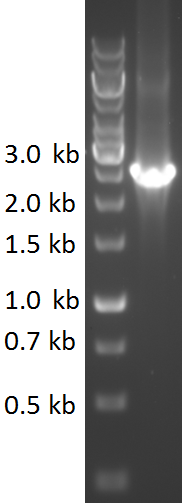Part:BBa_K2812006
Coding sequence for Pyocin S5 with HlyA and His6-tag
Coding sequence for Pyocin S5, which is a bacteriocin produced by a specific strain of P. aeruginosa and is effective against other strains of P. aeruginosa. The sequence encodes for an effector component that consists of a receptor binding domain, a translocation domain and a killing domain. Furthermore it contains an immunity component which gives immunity against the bacteriocin. The HlyA tag is a secretion signal peptide which is used for secretion via the Type 1 secretion pathway of gram-negative bacteria. In order to facilitate protein purification, an N-terminal HIS-tag is present.
Usage and Biology
Pyocin S5
The working mechanism of pyocin S5 involves making the target cell membrane permeable, causing leakage of intracellular materials. It has been demonstrated that is has antimicrobial activity against seven P. aeruginosa strains (DWW3, In3, In4, In7, In8, InA, and InB). P. aeruginosa PAO1, E. coli (BL21 (DE3), W3110, and ATCC15597) and S. aureus ATCC6538 were insensitive to pyocin S5. We as iGem Eindhoven 2018 aimed to use this biobrick for prevention of wound infections.
HlyA
The C-terminal sequence of Hemolysin A (residues 807-1024 of the E. coli HlyA gene) functions as a non-cleavable signal peptide for protein translocation via the Type I secretion pathway of Gram-negative bacteria. Here, HlyA is fused to the pyocin S5 for its secretion from E. coli BL21 (DE3) cells. In Type I secretion, single step transport of the target protein occurs from the cytoplasm to the extracellular environment. The HlyA is fused to the C-terminus of the target protein.3 It is a 23-kDa signal sequence that targets proteins for secretion via Type I secretion pathway. HlyA is secreted into the medium in a TolC and HlyB/D-dependent manner, in the presence of CaCl2.4 It is recognized by the membrane translocation complex composed of HlyB and HlyD, which together with the TolC protein, will form a pore through the membrane.5 This will lead to the secretion of HlyA-containing fusion proteins. Figure 1 illustrates the steps involved in the type I secretion of pyocin S5 as an HlyA fusion protein.
Thrombin linker & His-tag
The pyocin S5 and HlyA are linked via a thrombin linker. It is a short peptide sequence which can be cleaved by the enzyme thrombin, resulting in the removal of the HlyA domain. This avoids interference with the functionality of pyocin S5. C-terminal to the HlyA domain, a His-tag (6x repeated amino acid histidine) is attached. The His-tag can be used for detection of the fusion protein by e.g. Western Blot, but also for protein purification purposes as it facilitates binding to a nickel affinity column.
Fusion protein
The combination of all components described above, lead to a construct that can be (continuously) secreted by E. coli if the HlyB/D coding sequences have been co-transformed. Running the medium containing the fusion protein over a nickel affinity column and subsequent thrombin linker cleavage allows for the easy isolation of purified pyocin S5.
Figure 1. Agarose gel of the pyocin S5 with HlyA and His6-tag.
Sequence and Features
- 10COMPATIBLE WITH RFC[10]
- 12COMPATIBLE WITH RFC[12]
- 21INCOMPATIBLE WITH RFC[21]Illegal BglII site found at 137
Illegal BglII site found at 425
Illegal BglII site found at 2110 - 23COMPATIBLE WITH RFC[23]
- 25COMPATIBLE WITH RFC[25]
- 1000INCOMPATIBLE WITH RFC[1000]Illegal SapI.rc site found at 1200
//cds/enzyme
//cds/enzyme/lysis
//cds/membrane
//cds/membrane/lysis
//chassis/prokaryote/ecoli
//collections/biofilm
//plasmid/expression
//plasmidbackbone/proteinfusion
//plasmidbackbone/synthesis
//proteindomain
//proteindomain/cleavage
//proteindomain/degradation
//proteindomain/linker
//proteindomain/localization
| None |

